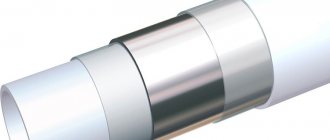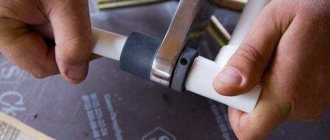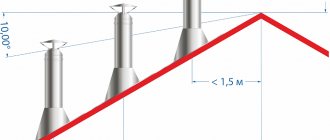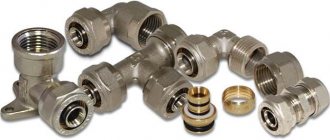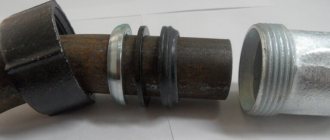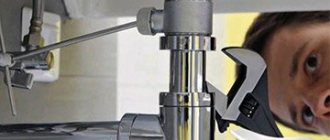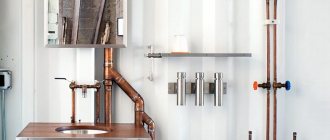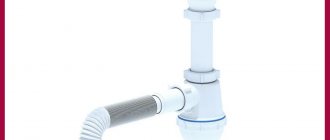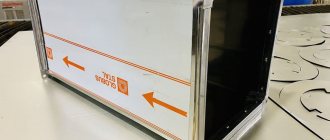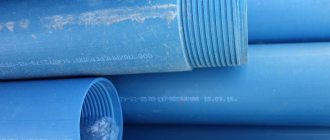Before installing a plastic pipeline on your own, you need to know the rules for assembling it and installing connecting elements. Installation of plastic products is not particularly difficult, but liability (including financial) for the consequences that occur as a result of improper installation and operation of the pipeline can be very high.
If you want to connect plastic water pipes with fittings, then you should choose polypropylene, metal-plastic, and polyethylene structures.
Connecting plastic water pipes with fittings
How to connect plastic pipes
There are several ways to install polymer pipes, each of which has its own characteristics. Experts recommend choosing how to connect plastic pipes depending on several conditions:
- purpose of the pipeline - water supply is often welded, sewerage is joined with sockets, heating is assembled with couplings of different types
- material of the products used - most polyvinyl chloride pipes are equipped with sockets; the industry produces compression couplings for assembling polyethylene lines; polypropylene pipes are soldered with manual or mechanical soldering irons
- scope of work - for heating pipes, installation of water supply, it is easier to buy a manual soldering iron, do the work yourself, connecting the external pipeline with sockets, for welding large diameters the services of specialized teams will be required
For polymer products, threaded connections are not used, since they cannot ensure sufficient tightness of the pipeline.
All other technologies remain available, with welding, sockets, and couplings being the most effective.
Comparison by cost
Self-installation of the presented types of pipes and fittings eliminates the cost of installation services provided by third parties and companies. At the same time, it is worth paying attention to the difference in the cost of the pipes themselves and their components. Metal-plastic pipes and fittings for them are an order of magnitude more expensive than similar products made of PVC and polypropylene for an obvious reason: the main material in them is non-ferrous metals. But to assemble metal-plastic pipelines, you do not need to buy or rent special equipment necessary for assembling polypropylene products. The difference in material costs is important for large volumes of work.
To solve different problems at one site, you can combine pipe connections from different materials; for this, manufacturers produce fittings that connect different types of products.
Connecting polymer pipes with couplings
HDPE compression couplings solve the question: “How to connect plastic pipes?” in drainage and water supply systems. They are used for standard sizes 50 – 16 mm, provide the necessary tightness and do not cause blockages.
The ends of the pipes are clamped with nuts, cone-shaped sealing rings that withstand the pressure of pressure water pipes, sewage drains, and heating circuits. There are compression couplings that are rigidly attached to the pipe body of a one-piece type.
In addition, threaded connections are used with flaring of the ends of the products after putting nuts on them. Each method is used depending on local conditions; the decision on how to connect plastic pipes is made depending on the material of the parts being joined.
In addition to compression couplings, there are similar fittings: tees, bends, plugs, flanges, saddles, taps.
Important installation details
PP pipes are connected using threaded/non-threaded fittings. In turn, threaded products can be:
one-piece; detachable.
It is worth noting that installation is primarily affected by operating conditions.
All polypropylene parts must be protected from fire. In the case of inserting a water meter or storage tank, it is advisable to use detachable threaded elements. However, a permanent connection is acceptable only for flexible hoses. Water meter The use of deformed or dirty connecting elements is strictly prohibited! Just like cutting threads yourself. When connecting flat sections or transitioning a pipeline to a different diameter, couplings are used. For turns, special angles are used; bending of pipes is unacceptable. Tees are used for branching the main line.
After you have read all the necessary information, you can start working.
Connecting polymer pipes by welding
Polymer welding is present in 50% of household communication systems; the joints have improved characteristics, since the process occurs at the molecular level.
The user manuals included in each set of welding equipment describe in detail the technology of how to connect plastic pipes and select the heating time depending on the wall thickness.
Hand soldering irons are used for products 50 – 16 mm; large diameters are soldered with mechanical welding machines. Removable sleeves heat the ends of the pipes, after which it remains to press them with slight force for a few seconds.
Welding with electric couplings is an improved version of the previous method, since the heating and joining process is controlled by a program. The quality of the joint increases, there is no need for fixation. Devices with electrodes are used to supply voltage to the heating elements inside the coupling.
Special connection methods
Push fittings, press fittings, flanges are special compounds of polymer materials.
They also solve the problem of how to connect plastic pipes in difficult cases: a joint with a metal main, a connection of different diameters. Push fitting allows you to use a minimum of tools (calibrator, knife). The fastening element consists of polyvinyl soufflon, brass, suitable for heating and water supply circuits.
The connection is considered permanent, the tightness is ensured by rubber rings. The pipe is inserted all the way into the fitting body, after which it is impossible to remove it back. Press fittings are crimped onto the body of the pipe with a hand wrench; they are also non-removable and are suitable for heating and water supply.
Source: aquagroup.ru
High tightness of joints with permanent connections
How to connect plumbing pipes using socket technology? Let's try to figure it out. This technique is considered the simplest and most common docking method. It can be easily done at home without any skills.
The sequence of actions is performed according to the following scheme:
- Clean the joints (socket, smooth end of the tubular product), and equip with rubber sealing rings.
- Coat the smooth end of the pipe with liquid soap or lubricant containing silicone.
- Connect both parts of the pipe until it stops so that there is no backlash.
- Place a mark on the smooth end of the pipe that corresponds to the actual joining depth.
Then, according to the set mark, you need to uncouple the pipe products by 10 mm relative to the level of greatest penetration. The socket must be directed against the direction of flow (about
Techniques for connecting plastic pipes with pipes made of other materials
When replacing outdated plumbing and heating systems, service companies are increasingly choosing plastic that is easier to install. Entire multi-storey entrances are equipped with polymer pipes.
This lightweight material, which is easy to cut, can give the impression that assembling a connection to a battery or bathtub will not pose any difficulties even for an inexperienced craftsman.
How to build a polymer riser for hot water or how to connect a plastic pipe to a metal one in a bathroom is a job the master must know thoroughly.
Rules for choosing technology
When determining the optimal assembly option, it is necessary to be guided by the performance characteristics of the system and material.
For the installation of water supply lines made of PVC pipes with a diameter exceeding 6.3 cm, it is customary to use compression couplings. If it is difficult to purchase fittings of suitable sizes, experts recommend using butt welding. The advantage of the method is that there is no need to purchase additional parts.
Socket technology has become widespread for self-connecting polyvinyl chloride structures of the same diameter. The correct location and giving the correct direction to the pipe line is achieved by using scrap iron. Inventive craftsmen use a jack.
For the assembly of non-pressure polyethylene systems, gluing can be used. Mechanical threads for mounting such products are recommended in special situations.
Characteristics of polymer pipes
Plastic pipes are a good alternative to outdated metal water pipes. Even a master inexperienced in technical aspects can easily name their advantages:
- reduced noise level from fluid movement compared to a metal counterpart;
- hermetic connection by monolithic soldering of homogeneous materials;
- resistance to environmental influences, and specifically to rust;
- smoothness of the inner surface, which does not allow sediment to accumulate.
Plastic pipes, which do not appear durable, are in fact only susceptible to strong impacts and sudden compression. Even an increase in internal pressure is less dangerous for them than for pipes made of metal or metal-plastic.
When transporting hot water, the pipe can expand, thereby reducing the risk of rupture. There are no difficulties in deciding how to connect plastic pipes to each other so that water hammer does not lead to an accident: a high-quality seam makes the joint no less durable than the walls of the pipe elbow itself.
The disadvantages of plastic communications are not so obvious, but we should not forget about them. First of all, these are the properties of expansion when heated up to a certain point, which is an advantage.
With significant heating of the environment, pipes can not only expand, but also elongate, which leads to loosening of threaded assemblies and non-monolithic connections. The critical temperature for polypropylene is considered to be +140°C, and this level is quite achievable in the event of a failure in the heating system.
The consequences of such an incident do not seem critical: the risk that the pipe will burst is practically eliminated. But the pipe can bend significantly and even destroy the masonry if placed in a hidden manner.
However, the advantages of plastic pipes are difficult to overestimate. This is the optimal material for cold water supply: by specifying how to connect the tap to a plastic pipe, you can set up a summer shower in a country house in a matter of hours, without using any specific equipment.
In addition, manufacturers of reinforced plastic pipes cope well with the problem of resistance to heat. A layer of plastic or fiberglass forms a kind of skeleton inside the pipe, preventing it from deforming under the influence of heat and pressure. You just have to take into account that when installing communications, pipes made of monolithic plastic and reinforced ones are considered different materials.
When deciding how to connect plastic pipes and plastic pipes with reinforcement, it is impossible to do without additional fittings, such as plastic fittings.
Installation of a pipeline made of plastic pipes
There is no question of how plastic pipes are connected to each other if they are the only material of the entire system. The plastic is mounted by soldering or connecting and/or distribution fittings made of the same material.
The use of metal components is not recommended: the difference in thermal conductivity will affect the quality of the connection. Methods for connecting plastic to other components depend on the material and type of reinforcement.
Building up
It is not difficult to understand how to connect plastic pipes for sewerage or water supply to extend them. The fitting for this type of material is a piece of a similar tube with a slightly larger diameter.
This capsule is placed over the cleaned and degreased edges and compressed with a special soldering iron set to medium temperature.
It’s not difficult to understand the working technique: soldering irons are designed for a certain standard diameter, so you don’t have to control the level of pressure and temperature. The connection turns out to be non-separable and even unnoticeable.
Connection with metal pipe
Connecting dissimilar pipes is more problematic. When figuring out how to connect a cast-iron sewer pipe with a plastic one or an outdated metal heating system with a modern one made of reinforced plastic, it is worth focusing on several important aspects:
- before choosing fittings, you must carefully measure the diameter of the metal elbow;
- to cut and strip a metal pipe you will need a grinder; The adapter between metal and polymer will be a plastic socket.
Having decided where and how to connect the plastic pipe to the cast iron one, you can begin installation. The operating procedure is as follows. The metal piece is cleaned and degreased. The seal is placed in the grooves of the socket and pressed tightly against the inner walls. After placing the pipes, the system is intercepted with clamps.
This technique is often used when installing a toilet. A successful alternative to such a system is a drain with a corrugated drain: since it is much easier to connect the corrugation with a plastic pipe.
Instead of fastening clamps, glue or sealant is used. Connection with a metal-plastic pipe To connect a plastic pipe with a metal-plastic pipe, collet fittings are used. Their basis is a thread applied to the outer part of the capsule. A pipe of the appropriate diameter is screwed onto it.
Collet fittings are commercially produced only for communications with a combination of materials, but also units designed for joining pipes of different diameters to each other. The use of press fittings with plastic materials is irrelevant.
You can install water supply and heating systems yourself, saving on calling a specialist. This can only be done if you are fully confident that your skills are sufficient to carry out such work.
Otherwise, the savings may be tripled to eliminate the consequences of the breakthrough.
Source: trubsovet.ru
PVC water lines
For manufacturing, polyvinyl chloride is used, the manufacturing method is extrusion. PVC plastic pipe has the following characteristics:
- service life – up to 50 years;
- density – 1.41 g/m3;
- ability to burn – non-flammable;
- elongation when heated – no more than 5%;
- The value of relative elongation at break is no more than 0.2%.
PVC plastic water pipes in the pressure version are equipped with a socket at one end to simplify installation. A rubber O-ring is installed in it. During assembly, no additional devices or equipment are used, which makes it possible to install the water supply system yourself.
The plastic material does not rot or corrode, so the water supplied through such a system is safe for use. The surface in contact with the liquid is smooth and always remains clean, since it does not deposit any substances of either organic or inorganic origin, which significantly increases the service life.
Their properties meet all the requirements of sanitary standards for the transportation of drinking water. At the same time, the equipment with additional elements for a wide variety of purposes allows you to create plastic pipeline networks of any degree of complexity.
PVC pipes are resistant to harsh ultraviolet radiation, which makes it possible to install open areas of external networks without additional insulation.
The disadvantages include low heat resistance, which allows their use at temperatures of no more than 65 degrees. Which prevents their use in networks with hot liquid. At the same time, when operating at temperatures below -10 degrees, the water supply system must be carefully insulated.
PVC markings and properties
Markings containing the following information are applied to the outer surface:
- PVC material type.
- A type of socket connection.
- Dimensions based on outer Ø and wall thickness.
- Intended use.
- Regulatory documentation (GOST or TU).
- Manufacturer's name and logo.
In addition, color design matters:
- Gray or corrugated black pipes are used for laying internal networks in free-flow or pressure form.
- Yellow or orange colors are used for external water supply or sewerage networks.
- White or blue colors of PVC pipes indicate the priority of use for casing water wells.
- Corrugated pipes have an inner surface of light gray or white. Their main area of application is deep highways, since these plastic products are characterized by increased strength in the radial direction.
Strength indicators of PVC pipes
According to the strength characteristics, polyvinyl chloride pipes are divided into three categories:
- light series, designated "L";
- middle series – “N”;
- heavy – “S”.
Belonging to the category indicated above prescribes the possibility of use for highways with different depths.
Spiral reinforced PVC pipes are produced by applying osneova to a spiral frame. This design allows them to be used on pipeline sections in the presence of vibration loads, for example, in a network adjacent to a pump, where it plays the role of a shock absorber.
Production is regulated by GOST 51613-2000, and the size range is specified in GOST 18599-2001.
The dimensions of plastic pipes are specified by GOST 28117-89 and represent a line of Ø (dia.) in the range from 5 to 630 mm with walls from 1 to 83 millimeters. In addition to being used in plumbing systems, they are used for laying electrical networks, transporting aggressive media, and also as a structural basis for the manufacture of various products.
We want to draw attention to the fact that a PVC plastic pipe is not suitable for hot water supply, it can only be used for cold liquids and when used at temperatures below 10 degrees it must be insulated.
Features of solderless connections
Connecting plastic pipes without soldering will not require large financial expenses. And you won’t have to get expensive soldering equipment from somewhere (obviously, not everyone has it) either.
It is worth admitting that the soldering process itself seems very complicated to some. A person must be able to properly handle a soldering machine, set the required pressure and temperature, and select solder. In general, in order to solder pipes efficiently, you really need to know a lot of nuances.
There is also an option such as soldering polypropylene pipes without a soldering iron. To do this, you simply take solder paste (this is a mixture of flux, solder powder and lubricant sold ready-made), apply it to the joint and heat it up.
Moreover, instead of a soldering iron, it is proposed to use a gas burner or lighter. But this method may also cause rejection for some, since here you have to deal with open fire.
Let's imagine a force majeure situation: there was a break in a plastic water pipe. It can take a long time to restore its seal by soldering. And restoring the tightness of pipes connected without soldering can be carried out much faster - this is a really important advantage.
Preparing for work
Before starting work, read a few important recommendations and prepare the necessary equipment.
Useful tips
If you have no experience welding plastic pipes with your own hands, first practice a little. Buy fittings and other wiring elements with a small margin. Once you gain experience, you will be able to complete the finishing work as quickly and efficiently as possible. If you have no experience in welding plastic pipes with your own hands, first practice a little. Before starting work, the joining elements must be properly prepared - cleaned and degreased. Without pre-treatment, you cannot count on a high-quality welded joint. During the wiring process, you will use not only pipes, but also various additional devices - turn signals, tees, couplings, etc. Remember: pipes must be heated from the outside, and all additional elements from the inside. Do not ignore this rule, otherwise the finished connections will be fragile and short-lived. The process of welding plastic pipes When welding plastic pipes with your own hands, especially if small parts are used in the process, make sure that the internal seams do not reduce the permeability of plastic products. Typically, this problem occurs when the pipes overheat - too much material builds up inside and the holes become clogged. Therefore, plastic pipes can only be welded at permissible temperatures (indicated in the instructions for the soldering iron). After completing the work, be sure to check the pipes for permeability. To do this, simply pass water through the product. The assembled system can be filled with water no earlier than 1-1.5 hours after welding the components.
We recommend: How to choose the right joint sealant for wood and log cabins
Required Tools
Prepare the following equipment:
special apparatus for connecting plastic pipes; Soldering iron Soldering iron nozzles for the pipes used; pipe cutter or special nippers; shaver (for metal-plastic pipes); Shaver is a tool for creating chamfers. Fusiotherm tool kit for welding polypropylene pipes
All necessary tools are sold in construction stores. A soldering iron is quite expensive, so if the work of welding plastic pipes is one-time, it will be more profitable to find a company that provides such tools for rent.
Use only recommended equipment. Some home craftsmen try to use ordinary household soldering irons for welding plastic pipes, but usually nothing good comes of it.
Connection with fittings
To connect plastic pipes without soldering, press fittings (also known as compression fittings) or new Belgian push fittings, which are actually fixed by themselves, are very often used.
Standard press fittings are usually made from steel alloy or cast iron. And they are best used for polypropylene or other plastic pipes of small diameter.
The advantage of these plumbing products is that they can be used to build transitions between pipeline elements and connect them at different angles.
Most often, fittings are installed on bends and branches of a plastic pipeline. An ordinary press fitting consists of a main body, a cover, a sleeve and two rings: a clamping ring (it is located in a special socket) and a seam ring (it is used to fix the plastic pipe).
If we are talking about fittings with a diameter of less than fifty millimeters, then they can be installed manually, without additional devices and equipment.
And one more important rule. The plastic pipe must first be prepared before installing the fitting - cut, remove burrs, clean from dust and degrease. Such preparation must be carried out in any case, regardless of the chosen connection method.
After the plastic product is brought into an acceptable condition, you need to install a nut on it, previously removed from the fitting. Next, a clamping ring is put on this nut. Now you can insert the pipe into the fitting as far as it will go and secure it. The same actions must be done with the second pipe being connected.
Preparatory work
Scheme of the future water supply
Before choosing materials and purchasing system components, it is necessary to think through and develop a detailed diagram of the future water supply system.
apartment water supply diagram
Take into account all the nuances: reliable taps at the entrance of the system, the location of furniture, meters and all plumbing fixtures, as well as additional terminals with plugs - for future or possible additional devices. The route of the future water supply system must be extremely optimal, with a minimum number of connections, intersections and repetitions, so as not to weaken the water pressure.
For clarity, you can draw a diagram on the wall or floor of the bathroom: this will allow you to find the best solutions for each faucet, appliance, tee, turn and intersection, as well as calculate the exact dimensions of plastic pipes, the number of connections and angles for each bend.
It is also necessary to think about future fastenings from special clamps; here it is worth considering that it is advisable to fasten plastic pipes for hot water more often (30 cm) than for cold water (40-60 cm), and take into account their possible expansion from heating - about 5 mm per 1 linear meter.
Preparation of materials and tools
Calculating the required number of parts and tools should take into account the following:
sizes of plastic pipes - the diameter of a water pipe for a conventional plumbing system can range from 11-13 to 21-23 mm, more complex systems with a large number of transitions and a large length will require a larger diameter; the required length is calculated with a mandatory margin and taking into account possible defects
Counting the number of plumbing parts
all types of fittings (couplings with the same or different sizes - for transitions between pipes of different diameters, angles with a rotation of 30, 45 and 90 degrees, plastic plugs for profile pipes, crosses, tees, bypasses, valves) clips for fastening (clamps) scissors for plastic pipes, a device for welding polypropylene pipes, a soldering iron - the so-called iron
Tip: To save money, scissors for plastic pipes can be replaced with an ordinary hacksaw, but this may deteriorate the quality of the connection.
Using flanges
You can connect plastic pipes with flanges without soldering. This joint is considered very reliable - metal flanges can withstand enormous positive temperatures and high pressure.
Today, even large-diameter pipelines are equipped with flanges. They provide a really strong connection.
Flanges for assembling household plastic pipelines are always threaded on one side only. As a rule, they are designed for a pressure of 1.6 MPa. At the same time, in stores you can find flange options with different sections - from 20 to 1200 mm.
The connection algorithm using flanges is quite simple. First of all, you need to carefully pull the flange onto the pipe and put on the rubber sealing gasket. The gasket should extend beyond the edge of the plastic pipe no more than one centimeter. Then the flange is carefully pushed onto this gasket.
At the next stage, joining with exactly the same flange of another plastic pipe is carried out. And the bolts here should be tightened very carefully. If you apply too much force, the plastic surface may crack.
Using couplings
An ordinary coupling for plastic pipelines is a fairly simple part in its design. It consists of:
- cast iron body;
- two nuts;
- rubber gaskets;
- four metal washers.
The coupling can be found at the nearest plumbing store, or, if you have certain skills and knowledge, you can make it yourself. In this case, the characteristics of the coupling must strictly correspond to the dimensions of the products being connected.
Ordinary couplings are suitable for both pressure plastic pipelines and pipelines without pressure. With their help, they provide a reliable connection of polypropylene without the use of a soldering iron.
To form a connection, the ends of the pipes must be inserted into the coupling so that they touch in the middle. The ends must pass through washers, gaskets and nuts. Then you need to tighten the nuts tightly so that the pressure on the gaskets is strong enough.
Joining plastic pipes with a coupling provides a 100% sealed seam, even without the use of soldering. But in certain cases, for example, if the pipe is short or adjacent directly to the floor (or other horizontal surface), it is not possible to install an ordinary coupling.
For such difficult cases, a clamping coupling was invented. How to use it? First you need to clean the edge of the plastic pipe. Then you need to unscrew the coupling and put all the fastening parts on the plastic product in the correct sequence. Moreover, the sealing ring should ultimately be located at a distance of at least one centimeter from the edge of the product.
Then you need to insert the body of the clamping coupling into the end of the plastic pipe. And then you need to move all the existing rings to this body and tighten the bolt. And to the thread located on the other side of the coupling, it will be necessary to attach an “American” fitting with a plastic pipe connected to it.
To control the strength of the connection, you must carefully pull the coupling towards you, holding the pipe to which it is attached with your free hand. The coupling must remain stationary.
If it moves, it means that the wrong size part was selected. That is why it adheres so poorly to the pipeline. However, this is easy to fix - you just need to tighten the threads.
Advice from professional builders
In order for plastic sewer pipes to serve for a long time and reliably, the following recommendations must be taken into account:
- Do not forget about high-quality gaskets and sealing materials where they are needed.
- Do not try to bend a plastic pipe, otherwise its service life will be sharply reduced.
- During installation, use special elements (angle, collet, compression fittings) to change the direction of the pipeline.
- For complex installations of sewer and drainage systems, especially in a private home, develop a diagram in order to do the work most efficiently.
Angles for connecting sewer pipes
If you decide to create a plastic sewer system yourself, you need to calculate its slope. It must be equal to or greater than the coefficient 0.02. This means that for every meter of horizontal sewer pipe, its ends should have a level variation of 2 cm. Moreover, the angle should go down towards the drain.
